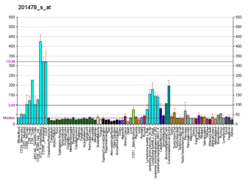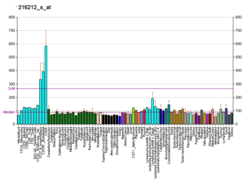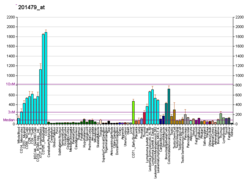Diskerin
H/ACA ribonukleoproteinski kompleks podjednica 4 je protein koji je kod ljudi kodiran DKC1 genom.[4][5][6]
Ovaj gen je član H/ACA snoRNPs familije gena (malih nukleolarnih ribonukleoproteina). snoRNP proteini učestvuju u raznim aspektima rRNK obrade i modifikacije. Oni se klasifikuju u dve familije: C/D i H/ACA. H/ACA snoRNP grupa takođe obuhvata NOLA1, 2 i 3 proteine. Protein kodiran ovim genom i tri NOLA proteina se lokalizuju u gustim fibrilarnim komponentama nukleola i u namotanim (Cajal) telima u nukleusu. Produkcija 18S rRNK i rRNK pseudouridilacija bivaju ometene ako se bilo koji od ova četiri proteina iscrpi. Protein kodiran ovim genom je srodan sa Saccharomyces cerevisiae Cbf5p i Drosophila melanogaster Nop60B proteinima.[6]
Klinički značaj
urediMutacije DKC1 gena su associrane sa Hoyeraal-Hreidarsson sindromom.[7]
Reference
uredi- ^ а б в GRCm38: Ensembl release 89: ENSMUSG00000031403 - Ensembl, May 2017
- ^ „Human PubMed Reference:”. National Center for Biotechnology Information, U.S. National Library of Medicine.
- ^ „Mouse PubMed Reference:”. National Center for Biotechnology Information, U.S. National Library of Medicine.
- ^ Heiss NS, Knight SW, Vulliamy TJ, Klauck SM, Wiemann S, Mason PJ, Poustka A, Dokal I (1998). „X-linked dyskeratosis congenita is caused by mutations in a highly conserved gene with putative nucleolar functions”. Nat Genet. 19 (1): 32—8. PMID 9590285. doi:10.1038/ng0598-32.
- ^ Hassock S, Vetrie D, Giannelli F (1999). „Mapping and characterization of the X-linked dyskeratosis congenita (DKC) gene”. Genomics. 55 (1): 21—7. PMID 9888995. doi:10.1006/geno.1998.5600.
- ^ а б „Entrez Gene: DKC1 dyskeratosis congenita 1, dyskerin”.
- ^ Lim, B. C.; Yoo, S. K.; Lee, S; Shin, J. Y.; Hwang, H; Chae, J. H.; Hwang, Y. S.; Seo, J. S.; Kim, J. I.; Kim, K. J. (2014). „Hoyeraal-Hreidarsson syndrome with a DKC1 mutation identified by whole-exome sequencing”. Gene. 546 (2): 425—9. PMID 24914498. doi:10.1016/j.gene.2014.06.011.
Literatura
uredi- Marrone A, Dokal I (2004). „Dyskeratosis congenita: molecular insights into telomerase function, ageing and cancer.”. Expert Reviews in Molecular Medicine. 6 (26): 1—23. PMID 15613268. doi:10.1017/S1462399404008671.
- Yamaguchi H (2007). „Mutations of telomerase complex genes linked to bone marrow failures.”. Journal of Nippon Medical School = Nihon Ika Daigaku zasshi. 74 (3): 202—9. PMID 17625368. doi:10.1272/jnms.74.202.
- Aalfs CM, van den Berg H, Barth PG, Hennekam RC (1995). „The Hoyeraal-Hreidarsson syndrome: the fourth case of a separate entity with prenatal growth retardation, progressive pancytopenia and cerebellar hypoplasia.”. Eur. J. Pediatr. 154 (4): 304—8. PMID 7607282. doi:10.1007/BF01957367.
- Maruyama K, Sugano S (1994). „Oligo-capping: a simple method to replace the cap structure of eukaryotic mRNAs with oligoribonucleotides.”. Gene. 138 (1–2): 171—4. PMID 8125298. doi:10.1016/0378-1119(94)90802-8.
- Devriendt K, Matthijs G, Legius E, et al. (1997). „Skewed X-chromosome inactivation in female carriers of dyskeratosis congenita”. Am. J. Hum. Genet. 60 (3): 581—7. PMC 1712491 . PMID 9042917.
- Suzuki Y, Yoshitomo-Nakagawa K, Maruyama K, et al. (1997). „Construction and characterization of a full length-enriched and a 5'-end-enriched cDNA library”. Gene. 200 (1–2): 149—56. PMID 9373149. doi:10.1016/S0378-1119(97)00411-3.
- McGrath JA (1999). „Dyskeratosis congenita: new clinical and molecular insights into ribosome function”. Lancet. 353 (9160): 1204—5. PMID 10217077. doi:10.1016/S0140-6736(99)00011-2.
- Knight SW, Heiss NS, Vulliamy TJ, et al. (1999). „X-linked dyskeratosis congenita is predominantly caused by missense mutations in the DKC1 gene”. Am. J. Hum. Genet. 65 (1): 50—8. PMC 1378074 . PMID 10364516. doi:10.1086/302446.
- Vulliamy TJ, Knight SW, Heiss NS, et al. (1999). „Dyskeratosis congenita caused by a 3' deletion: germline and somatic mosaicism in a female carrier”. Blood. 94 (4): 1254—60. PMID 10438713.
- Heiss NS, Girod A, Salowsky R, et al. (2000). „Dyskerin localizes to the nucleolus and its mislocalization is unlikely to play a role in the pathogenesis of dyskeratosis congenita”. Hum. Mol. Genet. 8 (13): 2515—24. PMID 10556300. doi:10.1093/hmg/8.13.2515.
- Knight SW, Heiss NS, Vulliamy TJ, et al. (2000). „Unexplained aplastic anaemia, immunodeficiency, and cerebellar hypoplasia (Hoyeraal-Hreidarsson syndrome) due to mutations in the dyskeratosis congenita gene, DKC1”. Br. J. Haematol. 107 (2): 335—9. PMID 10583221. doi:10.1046/j.1365-2141.1999.01690.x.
- Mitchell JR, Wood E, Collins K (1999). „A telomerase component is defective in the human disease dyskeratosis congenita”. Nature. 402 (6761): 551—5. PMID 10591218. doi:10.1038/990141.
- Yaghmai R, Kimyai-Asadi A, Rostamiani K, et al. (2000). „Overlap of dyskeratosis congenita with the Hoyeraal-Hreidarsson syndrome”. J. Pediatr. 136 (3): 390—3. PMID 10700698. doi:10.1067/mpd.2000.104295.
- Heiss NS, Bächner D, Salowsky R, et al. (2000). „Gene structure and expression of the mouse dyskeratosis congenita gene, dkc1”. Genomics. 67 (2): 153—63. PMID 10903840. doi:10.1006/geno.2000.6227.
- Pogacić V, Dragon F, Filipowicz W (2000). „Human H/ACA Small Nucleolar RNPs and Telomerase Share Evolutionarily Conserved Proteins NHP2 and NOP10”. Mol. Cell. Biol. 20 (23): 9028—40. PMC 86556 . PMID 11074001. doi:10.1128/MCB.20.23.9028-9040.2000.
- Hartley JL, Temple GF, Brasch MA (2001). „DNA Cloning Using In Vitro Site-Specific Recombination”. Genome Res. 10 (11): 1788—95. PMC 310948 . PMID 11076863. doi:10.1101/gr.143000.
- Simpson JC, Wellenreuther R, Poustka A, et al. (2001). „Systematic subcellular localization of novel proteins identified by large-scale cDNA sequencing”. EMBO Rep. 1 (3): 287—92. PMC 1083732 . PMID 11256614. doi:10.1093/embo-reports/kvd058.
- Knight SW, Vulliamy TJ, Morgan B, et al. (2001). „Identification of novel DKC1 mutations in patients with dyskeratosis congenita: implications for pathophysiology and diagnosis”. Hum. Genet. 108 (4): 299—303. PMID 11379875. doi:10.1007/s004390100494.




